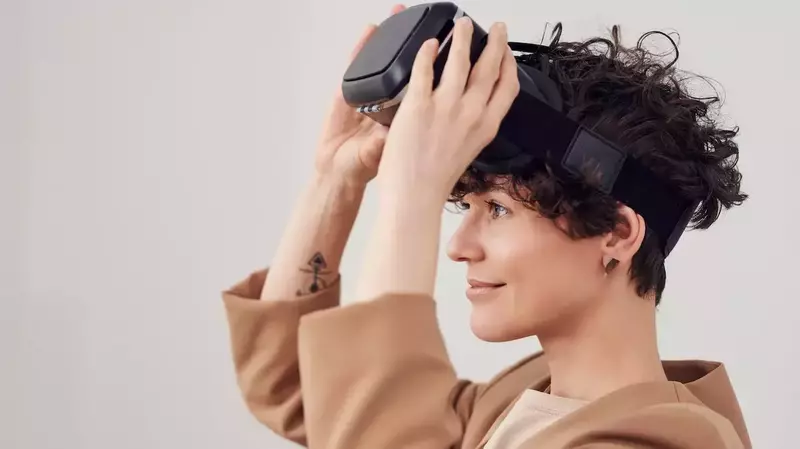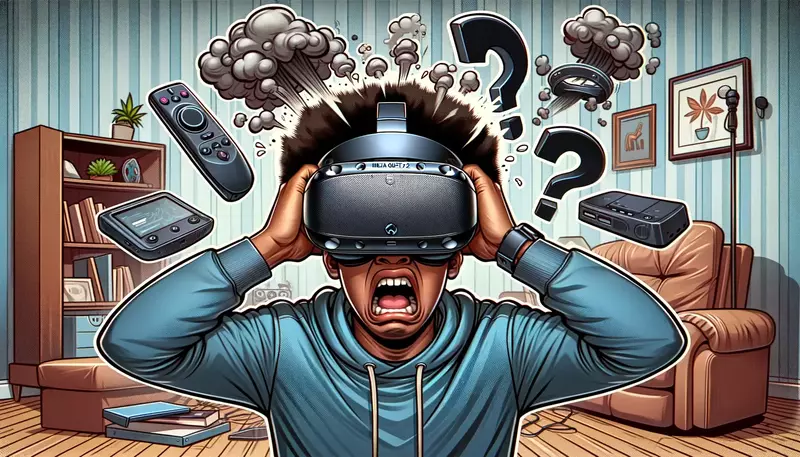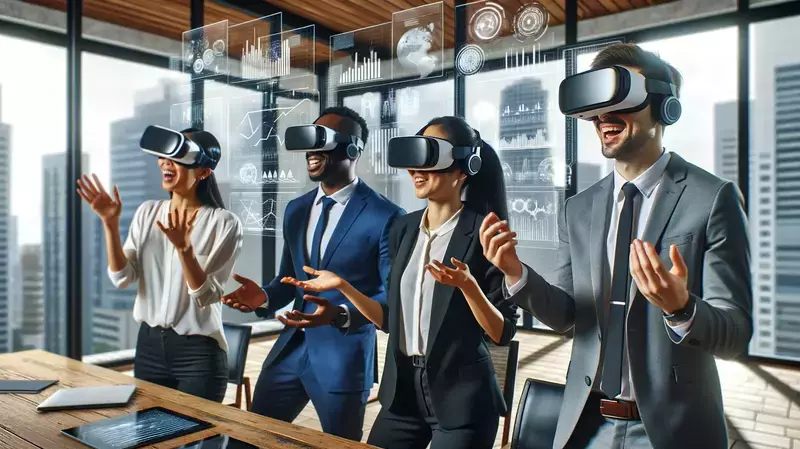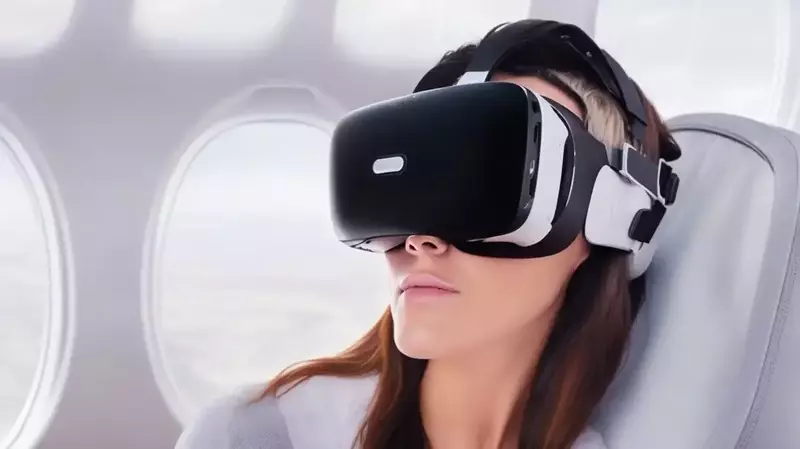This site contains affiliate links to products, and we may receive a commission for purchases made through these links.
Why does VR rely on slightly different views for each eye? The answer lies in the way our brain processes visual information to create a sense of depth and immersion.
By leveraging the natural ability of stereoscopic vision to provide depth perception, VR headsets are able to create a fully realized virtual environment for users.
Stereoscopic vision’s importance in creating depth perception will be discussed, as well as how VR utilizes this natural ability to provide an immersive experience and the benefits that come with it.
Then, we’ll delve into how VR utilizes this natural ability to transport users into a fully realized virtual environment. Furthermore, we will discuss the benefits that come with incorporating stereoscopic vision in VR experiences.
Finally, we will examine how exactly stereoscopic vision works within a VR headset and also consider some limitations that may arise when attempting to recreate this complex visual phenomenon digitally.
By understanding why does VR rely on slightly different views for each eye, you can better appreciate your friend’s virtual experience or even enhance your own journey through the entire virtual world.

What is Stereoscopic Vision?
Stereoscopic vision, also known as binocular vision, is the ability of humans and some animals to perceive depth and distance by combining two slightly different views of the same scene, one for each eye.
This unique visual capability allows us to accurately judge distances, recognize objects in three dimensions (3D), and navigate our surroundings effectively.
The human brain processes these separate images from each eye by comparing their differences in position, size, and shape. This process is called stereopsis, which results in a single 3D image that provides information about an object’s depth relative to the viewer.
Key Components of Stereoscopic Vision:
- Convergence: The inward movement of both eyes when focusing on a nearby object helps estimate its distance.
- Disparity: The difference between the positions of corresponding points on the retinas creates a sense of depth perception.
- Fusion: The combination of two slightly different images into one unified 3D image within our brains enables us to experience stereoscopic vision.
In addition to providing essential spatial awareness for everyday tasks like walking or reaching out for objects, stereoscopic vision plays a crucial role in various fields such as photography, film production (3D movies) and virtual reality (VR) technology – all aiming at creating immersive experiences with realistic depth perception.
Why Does VR Rely on Slightly Different Views for Each Eye?
Virtual reality (VR) is a technology that simulates a virtual world or environment that can be experienced through a VR headset. The goal of VR is to create an immersive experience that feels like the real world.
To achieve this, advanced VR headsets create stereoscopic vision by presenting slightly different views to each eye, just like in real life.
When we look at an object in the real world, each eye sees a slightly different view of the object. The brain combines these separate views to create a stereoscopic image that provides depth perception.
Similarly, VR headsets simulate binocular vision by presenting separate views to each eye, which the brain then combines to create a 3D image of the entire virtual world.
Without separate views for each eye, VR experiences would look like a two-dimensional picture, lacking the depth and immersion that is considered immersive. By presenting slightly different views to each eye, VR headsets create a sense of depth and realism that makes the virtual environment feel like a real world.
Overall, the use of separate views for each eye is a crucial component of VR technology that enables users to experience an immersive virtual world that feels like a friendly virtual experience or even the real world.
Comprehending stereoscopy is a necessity to gain an extensive appreciation of virtual reality’s potential. By exploring how VR utilizes stereoscopic vision, we can gain a deeper understanding of this revolutionary technology.
How Does VR Utilize Stereoscopic Vision?
Virtual reality (VR) relies on stereoscopic vision to create a realistic 3D environment to explore and interact with. This is achieved by presenting slightly different images for each eye, which the brain then combines into a single image with depth perception.
This piece will investigate the utilization of stereoscopic vision to create a realistic virtual reality experience.
The Role of Displays in VR Headsets
In order to utilize stereoscopic vision effectively, most VR headsets are equipped with two separate displays – one for each eye. These displays show slightly different images based on the user’s perspective within the virtual world. By doing so, they mimic the way our eyes naturally perceive depth and distance in real life.
Stereoscopic Rendering Techniques
To generate these distinct views for each eye, developers employ various rendering techniques when creating content for VR platforms.
One common method is called simultaneous multi-projection (SMP), which allows GPUs to render multiple viewpoints simultaneously without significant performance loss.
- Geometry-based: This technique involves rendering two separate scenes from slightly offset camera positions corresponding to the left and right eyes.
- Lens-matched shading: A more advanced approach where only parts of the scene visible through both lenses are rendered, reducing computational overhead while maintaining visual quality.
- Foveated rendering: By tracking the user’s gaze, this method only renders high-quality visuals in the area where they are looking, while reducing detail in peripheral vision to save on processing power.
Head Tracking and Stereoscopic Vision
Beyond rendering techniques, accurate head tracking is crucial for maintaining an immersive VR experience. Headsets use various sensors like accelerometers, gyroscopes, and external cameras to track head movements with precision.
This data is then used to adjust the displayed images accordingly so that users can explore virtual environments naturally by moving their heads.
In summary, stereoscopic vision plays a vital role in making VR experiences feel realistic and engaging. By using separate displays for each eye and employing advanced rendering techniques alongside precise head tracking systems, VR developers create 3D environments that truly immerse users into new worlds.
Stereoscopic vision offers a potent capability to VR designers, allowing them to craft an all-encompassing environment for users. By understanding the benefits of this technology, we can better appreciate how it contributes to our virtual reality experiences.
Moving forward, let’s explore what advantages stereoscopic vision provides in terms of VR performance and user experience.
Virtual reality (VR) uses stereoscopic vision by presenting slightly different images for each eye, which the brain combines into a single image with depth perception. VR headsets have two separate displays to mimic how our eyes perceive depth and distance in real life, while developers use various rendering techniques like simultaneous multi-projection (SMP), geometry-based rendering, lens-matched shading, and foveated rendering to generate distinct views for each eye. Accurate head tracking is also crucial for an immersive VR experience.
What are the Benefits of Stereoscopic Vision in VR?
VR headsets with stereoscopic vision offer a more immersive and realistic experience for users due to multiple advantages. These benefits include:
- Enhanced depth perception: By providing slightly different images for each eye, VR headsets simulate binocular vision and create an illusion of depth and distance, allowing users to better judge their surroundings within the virtual environment. This increased sense of spatial awareness is essential for activities such as gaming or architectural visualization.
- Better immersion: The accurate representation of three-dimensional space makes it easier for users to become fully immersed in the virtual world, leading to a more engaging and enjoyable experience overall. This level of immersion can be particularly beneficial when using VR applications designed for relaxation or meditation.
- Natural interaction with objects: Stereoscopic vision allows users to interact with virtual objects in a way that feels intuitive and natural, similar to how we interact with real-world objects on a daily basis. For example, grabbing an object or throwing a ball becomes much more straightforward when you have an accurate understanding of its position relative to your own.
Research has demonstrated that incorporating stereoscopic vision into VR experiences can not only increase performance but also enhance the user’s enjoyment.
In addition to these benefits, advanced VR headsets have made it possible for developers to create even more realistic environments by combining stereoscopic vision with other techniques such as parallax scrolling and motion tracking.
This creates a separate view for each eye, which is then combined to create a stereoscopic image that provides users with a more immersive experience.
The advantages of 3D sight in VR are plentiful, from a heightened feeling of being present to enhanced spatial awareness. By exploring the mechanics of this technology, we can gain a greater appreciation for its influence on our virtual reality journey.
Next, let’s take a look at how stereoscopic vision works in VR.
How Does Stereoscopic Vision Work in VR?
In order to create a realistic 3D environment, virtual reality (VR) headsets simulate binocular vision by using two separate displays that show slightly different images for each eye.
By presenting two separate visuals, a perception of depth and range is produced, permitting users to interact with virtual items in a more realistic fashion. Let’s dive deeper into the inner workings of stereoscopic vision in VR.
The Role of Parallax
Parallax, or the apparent change in position of an object when viewed from different angles, plays a crucial role in achieving stereoscopic vision within VR systems.
By presenting each eye with a slightly offset image, our brain is able to calculate depth based on the difference between these two perspectives – much like how we perceive depth naturally.
Display Technologies Used for Stereoscopic Vision
Different types of display technologies are used by various VR headset manufacturers to achieve this effect:
- OLED Displays: Organic Light Emitting Diode (OLED) displays offer fast refresh rates and low latency, which makes them ideal for providing smooth visuals needed for immersive experiences such as those found within virtual reality environments (source). Examples include the Oculus Rift and HTC Vive.
- LCD Panels: Liquid Crystal Display (LCD) panels are another popular choice due to their lower cost compared to OLEDs while still offering decent visual quality (source). An example would be PlayStation VR.
- MicroLED Displays: Although not yet widely adopted, MicroLED displays promise to offer higher resolution and improved energy efficiency compared to both OLEDs and LCD panels (source). This technology could potentially be used in future VR headsets.
The Importance of IPD Adjustment
To ensure that users experience optimal stereoscopic vision within a virtual environment, it’s essential for VR headsets to provide an interpupillary distance (IPD) adjustment. IPD refers to the distance between the centers of the pupils in each eye.
By adjusting this setting on their headset, users can achieve proper alignment with the displayed images for each eye, resulting in a more comfortable and immersive experience (source).
In summary, stereoscopic vision is achieved through careful manipulation of parallax using different display technologies while taking into account individual differences such as interpupillary distance.
This combination results in a realistic 3D environment that allows users to fully immerse themselves within virtual reality experiences.
Stereoscopic vision in VR offers a more immersive experience, yet it does have its drawbacks which will be discussed further. The next heading will explore what these limitations are and how they can be addressed.
Virtual reality (VR) headsets simulate binocular vision by using two separate displays that show slightly different images for each eye, creating an illusion of depth and distance. Parallax plays a crucial role in achieving stereoscopic vision within VR systems, while different display technologies such as OLEDs and LCD panels are used to achieve this effect.
What are the Limitations of Stereoscopic Vision in VR?
Stereoscopic vision is essential for creating a realistic virtual reality experience, yet it has its drawbacks, such as causing strain on the eyes when used over extended periods.
Some users may experience discomfort or nausea when using VR headsets for extended periods due to the strain on their eyes from constantly switching between two different views.
A. Visual Discomfort
The primary limitation associated with stereoscopic vision in VR is visual discomfort. When using a VR headset, each eye receives slightly different images that create an illusion of depth and distance.
Eye fatigue can result from our eyes needing to adjust frequently in order to bring into focus different elements of the simulated world.
B. Simulator Sickness
Another issue related to stereoscopic vision in VR is simulator sickness, which includes symptoms such as dizziness, headache, and nausea caused by prolonged exposure to virtual environments where visual input does not match physical movement or orientation.
- Vection: This occurs when your brain perceives motion based on visual cues alone while your body remains stationary – leading you to feel off-balance or disoriented.
- Mismatched Motion: In some cases, there might be inconsistencies between what you see and how your body moves within the virtual space – causing confusion and uneasiness.
- Lagging Head Tracking: If there’s any delay between head movements and corresponding visual changes, it can contribute to simulator sickness.
C. Limited Field of View
Most VR headsets provide a restricted field of view, which can obstruct the user’s capacity to accurately discern depth and distance.
A smaller FOV can make objects appear closer or farther away than they actually are, reducing the overall realism and immersion provided by stereoscopic vision in virtual reality experiences.
D. Individual Differences in Perception
Not everyone sees depth and distance in the same way, as individual variations such as eye dominance, interpupillary distance (IPD), and visual acuity can influence perception.
These variations might affect how users experience stereoscopic vision within VR environments, leading some individuals to have more difficulty adjusting than others.
In order for virtual reality technology to continue advancing and providing immersive experiences for all users, developers must address these limitations associated with stereoscopic vision while also considering individual differences among users.
Stereoscopic vision in VR has limitations that can cause visual discomfort, simulator sickness, limited field of view and individual differences in perception. These issues may affect users’ ability to adjust to virtual environments and developers must address them for the technology to continue advancing.
FAQ related to Why VR Relies on Slightly Different Views for Each Eye
How Does Virtual Reality Rely on Slightly Different Views for Each Eye?
This is achieved by displaying two separate images, one for each eye, with slight horizontal offsets. The brain combines these images into a single 3D image, creating an illusion of depth perception similar to what we experience in the real world.
Is VR Different for Each Eye?
Yes, VR displays separate images for each eye that are slightly offset horizontally. These differences help our brain perceive depth and create a three-dimensional experience within the virtual environment.
Do You Need Vision in Both Eyes for VR?
Vision in both eyes is preferable but not necessary to enjoy VR experiences. People with monocular vision can still use VR headsets; however, they may have reduced or limited depth perception compared to those with binocular vision.
How Does Virtual Reality Affect the Eyes?
The effects of virtual reality on the eyes vary depending on factors like duration and frequency of use. Some users may experience eyestrain or discomfort due to prolonged exposure or improper headset adjustment. Taking regular breaks and adjusting your headset properly can help minimize potential issues. [source]
What Are the Three “Eyes” of Virtual Reality?
The term “three ‘eyes’ of virtual reality” likely refers to three essential components: stereoscopic vision (two separate views), head tracking (detecting user’s movement), and spatial audio (creating realistic soundscapes). Together, these elements contribute significantly towards delivering immersive experiences within a virtual environment.
!! For more information about the different VR headsets on the market, check out this product specification list.
Final Thoughts
This technology mimics the way our eyes work in real life, allowing us to perceive objects in three dimensions.
Stereoscopic vision in VR offers enhanced realism, improved spatial awareness and heightened user involvement. However, there are also limitations such as potential discomfort or motion sickness.
If you’re interested in exploring the world of VR further and experiencing its full potential firsthand, check out Project PursuitMETA. Our team specializes in creating custom VR experiences that cater to your specific needs and preferences.

Espen
Espen is the Director of PursuitMeta and has written extensively about Virtual Reality and VR Headsets for years. He is a consumer product expert and has personally tested VR Headsets for the last decade.




Leave a Reply